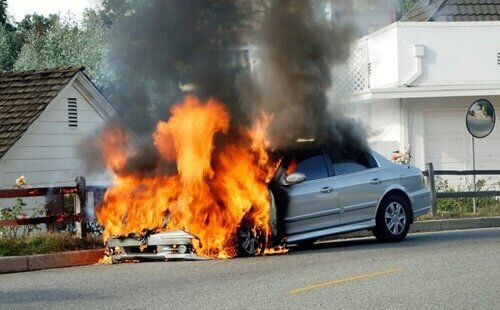In recent years, as many as 17 automobile fires have been reported on American streets every hour resulting in as many as four deaths per week. And according to statistics gathered by organizations like FEMA, in recent years automobile fires have been responsible for as much as 10% of all United States fires and 6% of fire deaths.
It is our belief that many of these deaths could have been avoided with proper precautions such as carrying a specifically designed automotive fire extinguisher in every vehicle you drive. Of all the advice in this article, the most important thing to know about automotive fire extinguishers is their purpose.
Car fire extinguishers are designed to save the occupants first and the vehicle second. If you are driving and smell something burning, pull over right away. Turn off your car’s engine immediately and get yourself and any other occupants a safe distance away from the car before inspecting the situation any further.
With all the different fire extinguishers on the market, how do you know you’re buying the right one? We’ve got you covered with a complete buying guide to the best car fire extinguishers, the different kinds of automotive fires, and the types of chemicals needed to combat them.
What Can Cause a Car Fire?
Even with the statistics listed above, it’s unlikely that your car is going to spontaneously catch on fire; there is usually a definitive cause behind car fires. Some fires do stem from manufacturer faults, which is part of why we see so many recalls these days. Famously, over a million Toyota Prius hybrids and another 215,000 Nissan SUVs were recalled because of fire hazards, but even recalls over things like ball joints or frame damage could mean that important components are compromised, increasing the risk of an accident and thus the risk of a fire.
Here are some of the most common reasons a car fire might begin:
Fluid leaks resulting from an accident
A fuel leak in the engine bay
Electrical shorts
Exhaust issues like a clogged catalytic converter
Excessive engine overheating
Criminal tampering or arson
Are Hybrid Cars More Susceptible to Fire?
There’s a popular myth circulating that electric and hybrid vehicles are more prone to fire than the conventional automobile. This myth is often perpetuated by followers of a large automotive television series where a pivotal character crashed a battery-powered supercar, resulting in a fire that burned for days.
With the sophisticated design of car batteries, while there have been many publicized instances of electric vehicles catching fire, recent National Fire Protection Association data has shown that hybrid and electric vehicles may actually be less susceptible to car fires than their internal combustion counterparts. But when a modern battery pack catches fire, those fires have been known to last for a long time and reignite without warning.
Some of the automotive fire extinguishers discussed in this article are designed for electrical systems as well.
Our resident car hoarder, Justin, uses the SS20 by Fire Fight Products
Types of Automotive Fire Extinguishers
Do not get a generic fire extinguisher from a local store. Those are designed primarily for structural fires like homes and may do more harm than good when fighting an automotive fire. Instead, look for one that has a UL Rating that is suitable for car fires.
Class A fire extinguishers – designed to put out ordinary combustibles like fabric and organic materials. These contain mono-ammonium phosphate.
Class B fire extinguishers – designed to put out flammable liquids like oil, gasoline, or paint. These may contain mono-ammonium phosphate or sodium bicarbonate.
Class C fire extinguishers – designed for electrical fires. These use a non-conductive agent to help isolate the fire event.
Your vehicle contains many fire hazards. From the gas, oil and electrical wires, you have a lot of risk around you. That’s why you need a car fire extinguisher that handles a multitude of situations.
It’s possible to use one extinguisher to protect your upholstery, plastic and wood components as well as any engine bay issues that may arise. For this you will want a fire extinguisher that contains a dry powder. The fire repellent inside of these is rated to fight most of the fires listed above. Plus, dry powder fights electrical and fuel accelerants.
What Size Fire Extinguisher Do I Need?
The size of a fire extinguisher is determined by its weight. For the average consumer, a two-pound fire extinguisher is more than enough to fight a small car fire. These are light enough to handle in a hurry and compact enough to fit securely in your car.
It is usually unnecessary to have a car fire extinguisher that weighs more than five pounds, but in the case of commercial vehicles (which must meet specific codes) and highly modified cars, larger sizes may be required.
While we believe all drivers should carry a car fire extinguisher, it’s even more crucial for anyone going off-road, racing, or driving a vintage or modified car. For these drivers, fire chance is significantly increased due to the automotive activities they participate in and a fully integrated fire suppression system might be justifiable.
Qualities to Look for in a Good Car Fire Extinguisher
When you begin shopping for the best car fire extinguishers, you’ll want to look for these essential features. Consider this your car fire extinguisher buying guide.
The ideal car fire extinguisher is a 2-pound aluminum cylinder actuated by a trigger and filled with a nonconductive chemical.
Lightweight – about two pounds is best.
Durable – look for something made from aluminum. It will be lightweight and corrosion-free.
Cylindrical – there are variations from the norm, but the best shape is still an elongated cylinder.
Easy to service – capable of being inspected, serviced, and refilled by a local company. Some extinguishers are not refillable.
Ready to use – with minimal steps required.
Controlled discharge – needs to come with a controllable trigger.
Warranty coverage – protection from faulty manufacturing.
Fire Standard Compliance – make sure there is a certification label on it.
Storage clip or mounting system – it needs to be mountable in your car as pictured below. You don’t want it rolling around in the seat or on the floor. You need to know exactly where it is at a moment’s notice.
Plan on a monthly inspection to ensure your extinguisher is still in good working order. Have it serviced annually, a process which often includes a recharge when applicable. Finally, try not to leave the extinguisher in prolonged direct sunlight or extreme temperatures for longer than necessary. These sorts of harsh environments can reduce the life and effectiveness of the extinguisher over time.
Keep it Handy: Storing a Car Fire Extinguisher
We have established the importance of car fire extinguishers, but there are people who still won’t use them. Their biggest concern is usually where they would store it. Not everyone has the room in their vehicle to accommodate a large fire extinguisher. Good thing the best automotive fire extinguishers are smallish 2-pound cylinders that can be easily mounted anywhere in the cabin.
When you’re trying to figure out where to mount a fire extinguisher, you’ll want to look at what works for others. Of course, the final location is going to be your personal preference. Some popular spots include on the roll bars (if your car has these, like a Jeep) and under the passenger seat. The trunk is popular as well, but for my money that’s too far away in the event of a fire. Above all, make sure it’s handy in case of an emergency.
Get Out Safely, Then Save the Car
The primary goal of an automotive fire extinguisher is to save the occupants from harm. The secondary goal is to save the car. This often contradicts the way people view these devices, but regardless of how much you have invested in your car, it can always be replaced. Your life and the lives of your occupants are far more valuable than your car.
If you are driving and smell something burning, pull over right away at the safest spot possible. You don’t want to wait until you can actually see flames to act. There is no harm in pulling over to check out what’s going on even if it’s nothing – better safe than sorry, as they say.
Once you’ve gotten off the road, turn off your car’s engine to prevent more fuel from flowing. Evacuate the car and get a safe distance away. Call for help and wait until emergency responders show up. Fight the urge to get back into the car to retrieve things – explosions and fireballs could happen at any time.
If you can see flames, it’s probably too late to fight the fire yourself. Car fire extinguishers are designed to get you out safely and fight small fires before they grow. If you see flames coming out of your engine bay, DO NOT open the hood completely. Feeding oxygen to the fire simply causes it to grow faster and more rapidly. If you can crack it slightly, you might try to shoot the fire extinguisher inside, but even this is rarely suggestable and can be highly dangerous.
Once you have used your car fire extinguisher, you want to have it serviced. You may be able to use the remainder of a partially discharged extinguisher, but some models do not allow for this. Some models allow for refills while others do not. If you are unsure, have a local facility inspect your fire extinguisher or call the manufacturer.
Helpful Emergency Gear to Complement Your Fire Extinguisher
Other than purchasing the best fire extinguisher for your car, there is some other gear you should consider keeping on hand. We’re talking of course about an Emergency Roadside Kit which may include a fire blanket, small pylons, maintenance tools and gear for cold weather.
We hope you never need to use a car fire extinguisher, but we want you to be prepared just in case. Knowledge might make the difference of whether you live or become a scary statistic. Equip yourself with the best fire protection to ensure your safety on the road. After all, you can never be too prepared when it comes to fire safety.
Dirt Legal provides VIN Checks and title replacement for cars, motorcycles, and almost anything with wheels. Click the links to learn more about our services.
We are not attorneys. This article is not legal advice. Cover image source


















From jumping your own battery to inflating your own tires, you never know when you might need to help yourself.